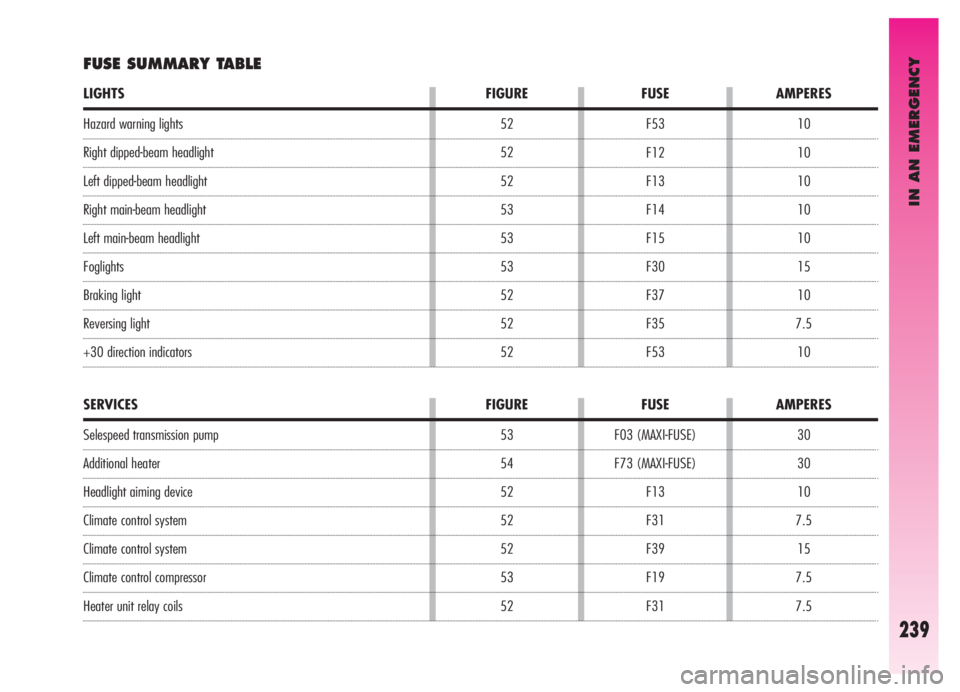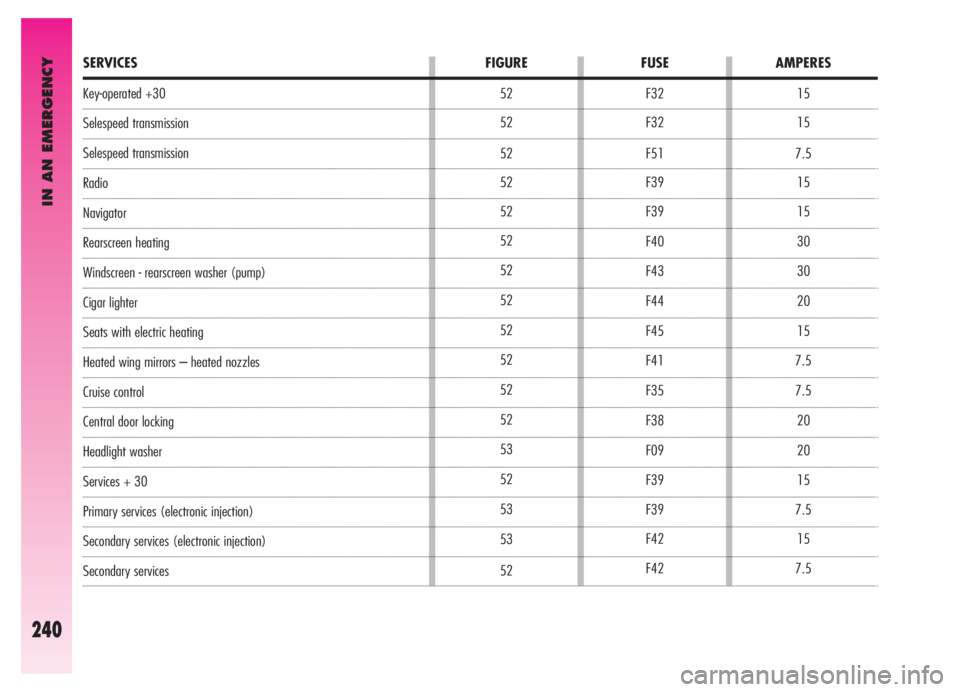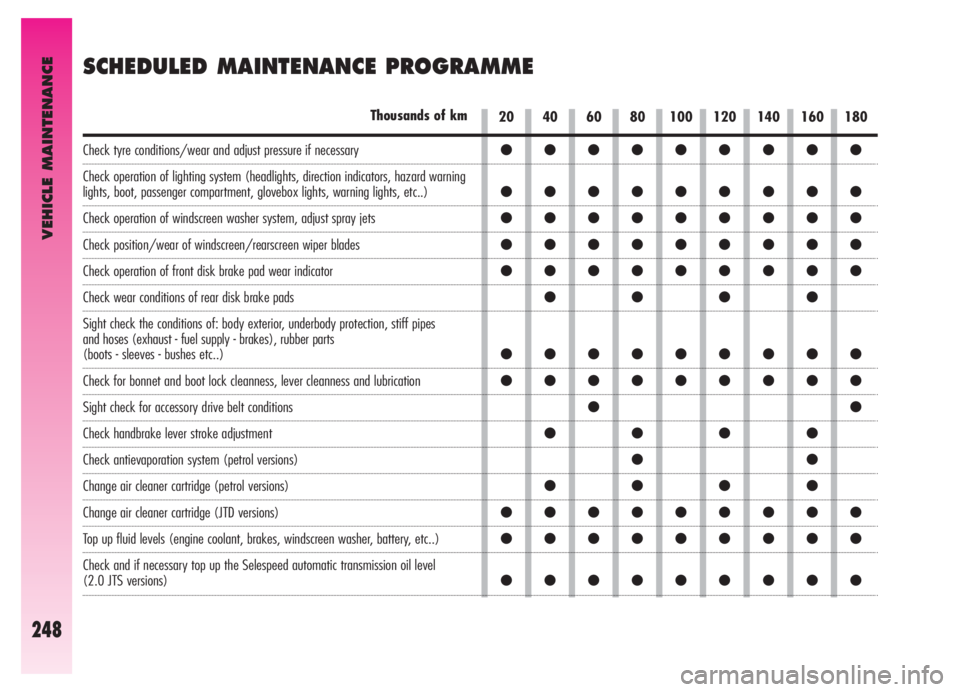Alfa Romeo GT 2005 Owner handbook (in English)
Manufacturer: ALFA ROMEO, Model Year: 2005, Model line: GT, Model: Alfa Romeo GT 2005Pages: 307, PDF Size: 6.05 MB
Page 241 of 307

IN AN EMERGENCY
239
30
30
10
7.5
15
7.5
7.5 F03 (MAXI-FUSE)
F73 (MAXI-FUSE)
F13
F31
F39
F19
F31
SERVICES FIGURE FUSE AMPERES
Hazard warning lights
Right dipped-beam headlight
Left dipped-beam headlight
Right main-beam headlight
Left main-beam headlight
Foglights
Braking light
Reversing light
+30 direction indicators10
10
10
10
10
15
10
7.5
10 F53
F12
F13
F14
F15
F30
F37
F35
F53
LIGHTS FIGURE FUSE AMPERES
FUSE SUMMARY TABLE
Selespeed transmission pump
Additional heater
Headlight aiming device
Climate control system
Climate control system
Climate control compressor
Heater unit relay coils52
52
52
53
53
53
52
52
52
53
54
52
52
52
53
52
Page 242 of 307

IN AN EMERGENCY
240
15
15
7.5
15
15
30
30
20
15
7.5
7.5
20
20
15
7.5
15
7.5 F32
F32
F51
F39
F39
F40
F43
F44
F45
F41
F35
F38
F09
F39
F39
F42
F42
SERVICES FIGURE FUSE AMPERES
Key-operated +30
Selespeed transmission
Selespeed transmission
Radio
Navigator
Rearscreen heating
Windscreen - rearscreen washer (pump)
Cigar lighter
Seats with electric heating
Heated wing mirrors – heated nozzles
Cruise control
Central door locking
Headlight washer
Services + 30
Primary services (electronic injection)
Secondary services (electronic injection)
Secondary services52
52
52
52
52
52
52
52
52
52
52
52
53
52
53
53
52
Page 243 of 307

IN AN EMERGENCY
241
Volumetric sensors
ESP system sensor
Steering angle sensor
EOBD system diagnosis socket
Cell phone provision
Driver’s door control unit supply
Passenger’s door control unit supply
Control lighting
Climate control system control lighting
Instrument cluster
Instrument cluster
Driver’s door control unit
ABS control unit
ABS control unit
Dashboard control unit
Air - bag control unit
Electronic injection control unit +30
Engine compartment control box (petrol versions)
Dashboard control unit
Trailer control unit15
7.5
7.5
15
15
20
20
7.5
7.5
10
10
15
7.5
50
50
7.5
7.5
125
70
10 F39
F42
F42
F39
F39
F47
F48
F49
F35
F37
F53
F39
F42
F04 (MAXI-FUSE)
F02 (MAXI-FUSE)
F50
F18
F70 (MEGA-FUSE)
F71 (MAXI-FUSE)
F36 52
52
52
52
52
52
52
52
52
52
52
52
52
53
53
52
53
54
54
52
SERVICES FIGURE FUSE AMPERES
Page 244 of 307

IN AN EMERGENCY
242
40
30
50
15
15
15
15
25
7,5
15
15
30
30
50
20
150
40
60
20 F05 (MAXI-FUSE)
F06 (MAXI-FUSE)
F07 (MAXI-FUSE)
F10
F21
F22
F21
F60 (*)
F16
F61 (*)
F62 (*)
F08
F72 (MAXI-FUSE)
F01 (MAXI-FUSE)
F20
F70 (MEGA-FUSE)
F06 (MAXI-FUSE)
F07 (MAXI-FUSE)
F22 53
53
53
53
53
53
53
52
53
52
52
53
54
53
53
54
53
53
53
SERVICES FIGURE FUSE AMPERES
(*) Fuse behind dashboard control box on an auxiliary bracket.
Climate control fan
Radiator fan (first speed - petrol versions)
Radiator fan (second speed - petrol versions)
Horn
Fuel pump
Injectors (petrol versions)
Ignition coils
Tailgate electric unlocking
Electronic injection system
Bose system
Bose system
Additional heater
Ignition switch
Glow plug warming (JTD versions)
Heated fuel oil filter (JTD versions)
Engine compartment control box (JTD versions)
Radiator fan (first speed – JTD versions)
Radiator fan (second speed – JTD versions)
Injectors (JTD versions)
Page 245 of 307

IN AN EMERGENCY
243
IN THE EVENT OF A FLAT BATTERY
Before anything else, you are advised to
read the precautions for preventing the
battery from draining and for ensuring
long life in the “Vehicle maintenance”
chapter.
CHARGING THE BATTERY
IMPORTANTThe battery charging
procedure is described only for information
purposes. This operation should be carried
out by Alfa Romeo Authorised Services.
Charging should be slow at a low amp
rating for 24 hours. Charging for a longer
time may damage the battery.Charge the battery as follows:
– Disconnect the battery negative termi-
nal (–).
– Connect the charger cables to the bat-
tery terminal ensuring that the bias is cor-
rect.
– Turn on the charger.
– After charging, turn off the charger
before disconnecting it from the battery.
– Re-connect the battery negative termi-
nal (–).The liquid contained in
the battery is poisonous
and corrosive. Avoid con-
tact with the skin or eyes. The
battery should be charged in a
well ventilated place, away from
naked flames or possible sources
of sparks: danger of explosion
and fire.
Do not attempt to
charge a frozen battery:
it must firstly be thawed,
otherwise it may burst. If freez-
ing has occurred, the battery
should be checked by skilled per-
sonnel to make sure that the
internal elements are not dam-
aged and that the body is not
cracked, with the risk of leaking
poisonous and corrosive acid.
Page 246 of 307

IN AN EMERGENCY
244
IF THE VEHICLE IS TO BE TOWED
The tow ring supplied with the vehicle is
housed in the tool box under the boot
mat.
To install the tow ring, proceed as fol-
lows:
– Take the tow ring from the tool box.
– Remove the cover (A) snap-fitted on
the front (fig. 55) or rear (fig. 56)
bumper. To do this, using the flat-bladed
screwdriver provided, protect the tip with
a soft cloth to avoid damaging the car.– Firmly screw the ring in its housing.
fig. 55 - front
A0A0650b
fig. 56 - rear
A0A0670b
Before tightening the
ring carefully clean the
threaded housing. Before
beginning to tow the car, make
sure that the ring is firmly tight-
ened in its threaded housing.
Before starting to tow,
turn the ignition key to
MAR and back to STOP,
again without removing it.
Removing the key automatically
engages the steering lock result-
ing in the impossibility to steer
the wheels. When towing
remember that without the help
of the engine brake and power
steering greater effort is required
on the pedal and steering wheel.
Do not use flexible cables for
towing and avoid jerks. During
towing operations make sure
that fastening the joint to the car
does not damage the components
in contact with it. When towing
the car, it is compulsory to follow
specific traffic regulations con-
cerning both the towing device
and behaviour on the road.
Page 247 of 307

IN AN EMERGENCY
245
Take care when position-
ing the arms of the lift or
workshop lift to avoid
damaging the side strips.
USING AN ARM LIFT OR
WORKSHOP LIFT
The vehicle should be lifted only at the
side, setting the end of the arms or the
workshop lift in the illustrated areas, at
approx. 40 cm from the wheelhouse pro-
file (fig. 57).These areas are highlighted by the sym-
bol
▼on the lower part of the side mem-
ber.
The car may fall if the
jack is not positioned cor-
rectly. Never use the jack
for higher capacities than the one
stated on the label.
IMPORTANTFor versions with
Selespeed transmission, make sure that
the gears are in neutral (N) (checking
that the vehicle moves if pushed) and
then proceed as for towing a normal car
with mechanical transmission, following
the instructions given previously.
Should it be impossible to set the gears
to neutral, do not tow the car and contact
Alfa Romeo Authorised Services.Do not start the engine
when towing the car.
IF THE VEHICLE IS TO BE LIFTED
fig. 57
A0A0672b
Page 248 of 307

IN AN EMERGENCY
246
other crashes is high. Leave the car imme-
diately and go beyond the guard-rail.
– If doors are blocked, do not try to get
out of the car breaking the windscreen
which is stratified. The windows and rear
screen are easier to break.
– Remove the ignition key of the vehi-
cles involved.
– If you note a smell of fuel or other
chemical products, do not smoke and
have a cigarette stubbed out.
– To put out fires, even small ones, use
the extinguisher, blankets, sand, or earth.
Never use water.
– If use of the lighting system is not nec-
essary, disconnect the battery negative
terminal (–).IN THE EVENT
OF AN ACCIDENT
– It is important to keep calm.
– If you are not directly involved, stop at
least a few dozen metres away from the
accident.
– On motorways, stop without blocking
the emergency lane.
– Turn the engine off and the hazard
warning lights on.
– At night, illuminate the place of the
accident with the headlights.
– Take care, do not risk being run over.
– Signal the accident placing the trian-
gle at regulation distance in a clearly visi-
ble place.
– Call the emergency organisation, giv-
ing the most accurate information possi-
ble. On motorways use the special phones
provided.
– In motorways pileups, especially with
poor visibility, the risk of being involved in
IF PEOPLE ARE INJURED
– An injured person must never be aban-
doned. Helping is compulsory also for per-
sons not directly involved in the accident.
– Do not crowd around injured people.
– Reassure the injured person that help
is on the way, and stay near to overcome
any panic.
– Release or cut the seat belt restraining
injured persons.
– Do not give injured persons anything
to drink.
– An injured person should never be
moved except in the following circum-
stances.
– Remove an injured person from the
car only in danger of fire, sinking or
falling. When removing an injured person:
do not pull the limbs or bend the head and
keep the body as horizontal as possible.
FIRST AID KIT
In addition to the first-aid kit, it is also
wise to keep an extinguisher and a blan-
ket in the car.
Page 249 of 307

VEHICLE MAINTENANCE
247
It is however wise to remember that
Programmed Maintenance does not com-
pletely cover all the car’s requirements:
also in the initial period before the
20,000 km service coupon and later,
between one coupon and another, ordi-
nary care is still necessary such as for
example routinely checking and topping
up the level of fluids, checking the tyre
pressure, etc...
IMPORTANTThe Programmed Mainte-
nance coupons are specified by the Manu-
facturer. The failure to have them carried out
may invalidate the warranty.
The Programmed Maintenance service is
carried out by all Alfa Romeo Authorised
Services, at pre-established times.If during each operation, in addition to
the ones programmed, the need arises for
further replacements or repairs, these may
be carried out only with the explicit agree-
ment of the customer.
IMPORTANTYou are advised to con-
tact Alfa Romeo Authorised Services in the
event of any minor operating faults, with-
out waiting for the next service coupon. SCHEDULED
SERVICING
Correct maintenance is determined in
ensuring long vehicle life under the best
conditions.
This is why Alfa Romeo has programmed
a series of checks and maintenance oper-
ations every 20,000 km.
IMPORTANTOn versions fitted with
reconfigurable multifunction display, at
2000 km from the maintenance deadline,
the display will show “REFER TO SERVICE
MANUAL” which is shown again turning
the ignition key to MAR, every 200 km.
For further details, see “Service” in the
“Reconfigurable multifunction display”.
V V
E E
H H
I I
C C
L L
E E
M M
A A
I I
N N
T T
E E
N N
A A
N N
C C
E E
Page 250 of 307

VEHICLE MAINTENANCE
248
SCHEDULED MAINTENANCE PROGRAMME
20 40 60 80 100 120 140 160 180Thousands of km
Check tyre conditions/wear and adjust pressure if necessary
Check operation of lighting system (headlights, direction indicators, hazard warning
lights, boot, passenger compartment, glovebox lights, warning lights, etc..)
Check operation of windscreen washer system, adjust spray jets
Check position/wear of windscreen/rearscreen wiper blades
Check operation of front disk brake pad wear indicator
Check wear conditions of rear disk brake pads
Sight check the conditions of: body exterior, underbody protection, stiff pipes
and hoses (exhaust - fuel supply - brakes), rubber parts
(boots - sleeves - bushes etc..)
Check for bonnet and boot lock cleanness, lever cleanness and lubrication
Sight check for accessory drive belt conditions
Check handbrake lever stroke adjustment
Check antievaporation system (petrol versions)
Change air cleaner cartridge (petrol versions)
Change air cleaner cartridge (JTD versions)
Top up fluid levels (engine coolant, brakes, windscreen washer, battery, etc..)
Check and if necessary top up the Selespeed automatic transmission oil level
(2.0 JTS versions)
●●●●●●●●●
●●●●●●●●●
●●●●●●●●●
●●●●●●●●●
●●●●●●●●●
●●●●
●●●●●●●●●
●●●●●●●●●
●●
●●●●
●●
●●●●
●●●●●●●●●
●●●●●●●●●
●●●●●●●●●